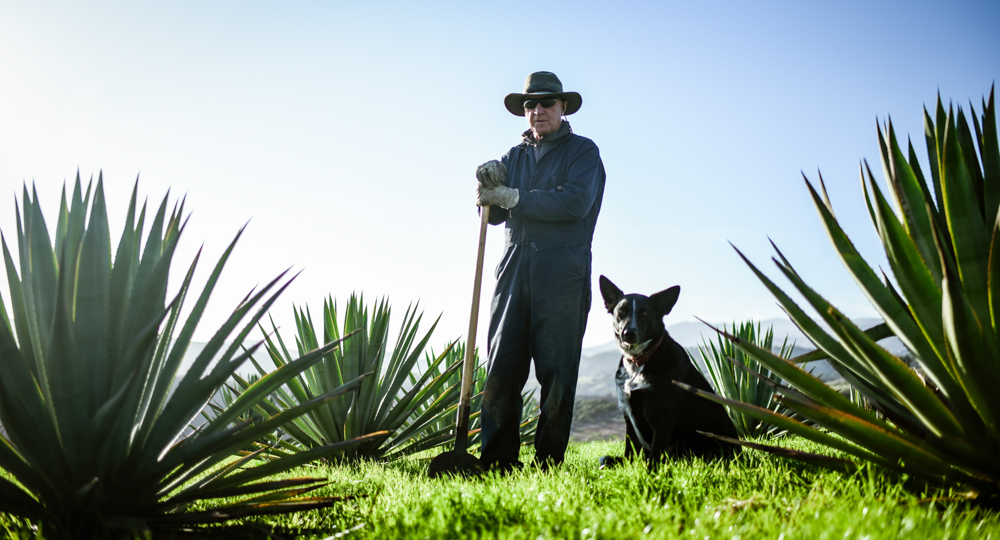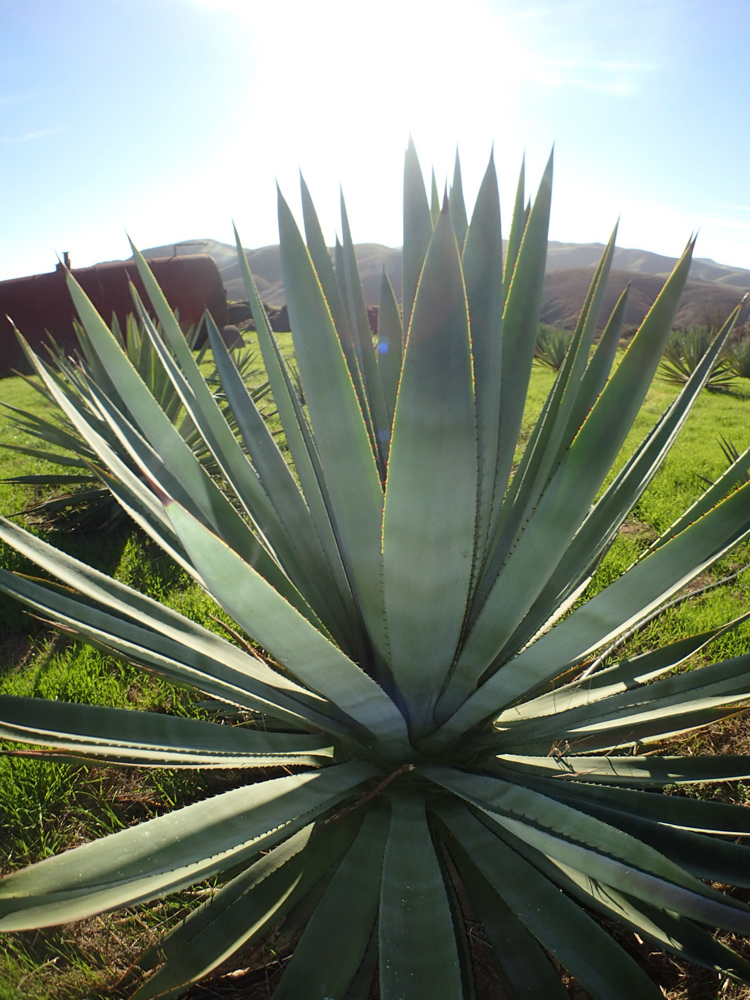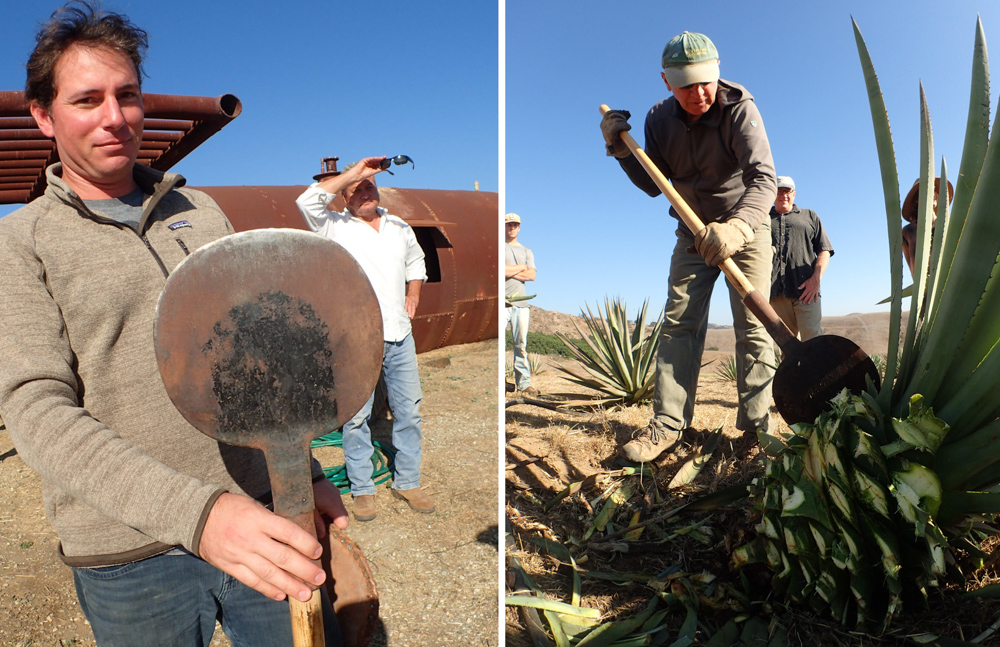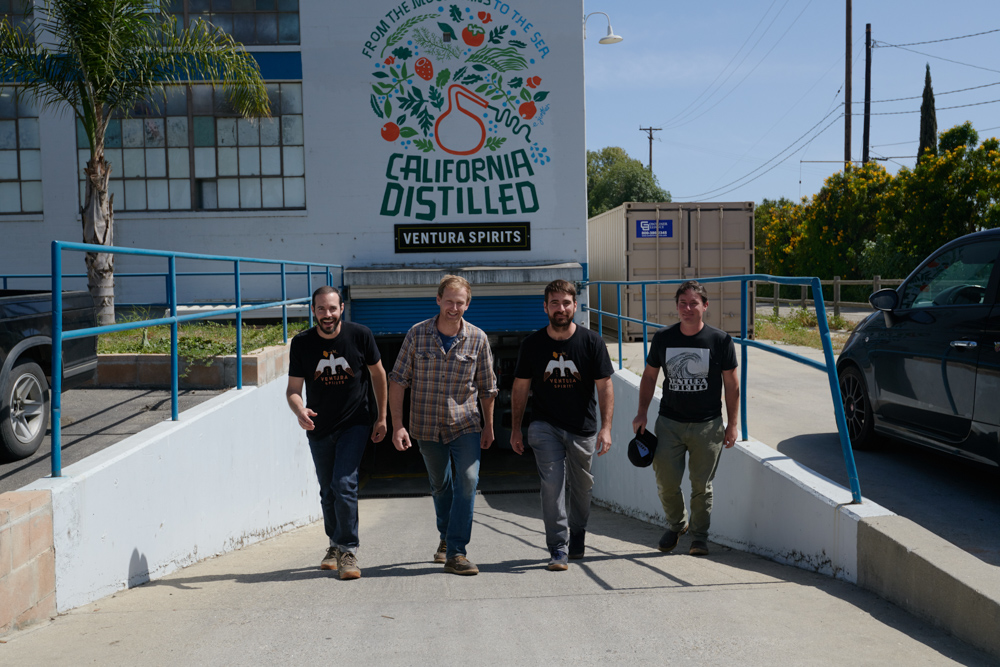
By everyone’s admission, the first harvests of blue agave on the Gaviota Coast have been a bit clumsy. Unlike plucking fruits, picking vegetables, or mowing grains — activities that are familiar enough to the everyday Californian farmer — these sharp-spined, sturdy plants are much more bizarre beasts. Their fibrous leaves must first be severed with a spade-like tool called a coa, and then the shallow, spindly roots are hacked away to release the piña. That oversized, pineapple-looking orb — which can grow as big as 150 pounds, although these early ones are only a third that size — is then chopped into chunks that will later be cooked, mashed, juiced, fermented, and distilled into liquor.
It’s backbreaking work, especially when you don’t really have anyone to teach you the way, and the three harvests that have happened so far at La Paloma Ranch in the foothills above Refugio State Beach have been peppered with plenty of laughter, speculation over proper technique, and severely poked butt cheeks. (“Harvest” is itself a clumsy word: Only five piñas have been unearthed in total so far.) The inexperience extends from the growing — these first agaves surprised everyone by maturing and shooting their flower stalks much sooner than the 7-10 years expected — to the processing, as the men down the coast at Ventura Spirits who’ve mastered the distillation of grain and fruit are perplexed by how to best convert these cacti into booze. (Technically, agave aren’t even cacti, but more closely related to the lily species.)
Of course, a steep, slightly silly learning curve is only natural when it comes to the first crack at a new crop. Agave, as most everyone knows by now, is the basis for Mexico’s famed tequila, one of the most sought-after liquors in the world. But tequila — which can only be made from Agave tequilana, aka blue agave, in Jalisco and a few surrounding states in Mexico — is merely an intensely regulated version of mezcal. That’s the name for spirits distilled from more than three dozen species of agave throughout Mexico, from the massive Agave mapisaga (which grows 14 feet tall and wide) to the more diminutive Agave potatorum, whose two-foot-wide piñas are turned into coveted $150 bottles labeled “Tobala.”

So when it comes to turning agave into alcohol, Mexico enjoys a firm head start over California. The indigenous Mesoamericans came first, making a fermented, beer-like beverage called pulque from agave for at least 1,000 years. There’s a sliver of research that suggests distillation may have occurred prior to Spanish contact, but the dominant belief is that it was the conquistadors of the 1600s who first started making liquor out of the plant when they grew thirsty for brandy. The tradition was professionalized over the next two centuries, primarily by the Cuervo and Sauza families. In 1974, the Mexican government protected and regulated the “tequila” name, much like France owns “Champagne,” and did the same for “mezcal” in 1994.
The country is vigilant in their defense of those monikers, and purists are probably smirking to learn that their neighbors to the north are embarking on a grand agave experiment. La Paloma’s owner, Eric Hvolboll — whose family has tended to this slice of land for more than 150 years — is the first to admit the whole thing could completely fail. “It might just be a lark and we don’t continue it,” he said. “But we won’t know for a number of years.”
What no one is laughing about here in California, though, is the potential that agave presents for the Golden State’s drought-parched, fire-prone landscape. The plants use far less water than avocados or citrus, thrive in marginal soils where little else will grow, and are so naturally waterlogged that they can stop a wildfire in its tracks. Doug Richardson witnessed that firsthand behind his Toro Canyon home during the Thomas Fire of 2017, which couldn’t penetrate the line of cacti that he planted.
“Driving around Santa Barbara all these years, I’ve seen so many clumps of agave that are suitable for making distilled spirits just growing out on their own,” said Richardson, a longtime farmer, former SBCC professor, and landscape contractor in Carpinteria who’s fast becoming the prophet of North American agave. “I thought, ‘This is something we should look into.’ And I am definitely someone who really enjoys the distilled spirit form of agave in mezcal and tequila.”
Banana Man to Cacti Guy
“That’s mapisaga — it just thrives in California,” says Doug Richardson one morning at his nursery, which sits near the polo fields under the charred Carpinteria cliffs. He’s excitedly showing off the many species of agave that he’s collected and propagated in recent years, including this one, a preferred pulque variety in Mexico. “Look at the offshoots,” he continues. “It’s just prolific.”
Widely known as “The Banana Man” for the 15 years he farmed that tropical fruit at La Conchita in the 1980s and ’90s, Richardson is no stranger to exotic species. Raised in Manhattan Beach, he came to the University of California, Santa Barbara, to study geography but got caught up in farming while reviving an old apple orchard atop Kinevan Ranch off of San Marcos Pass, where he lived during college.
“I’m pretty much a self-taught agricultural guy, but I’ve been doing it continuously since I was about 18 — I just had my 70th birthday,” said Richardson, whose salt-and-pepper, shoulder-length hair and tanned, ever-outdoors skin looks at least 10 years younger. Among other accomplishments in his landscaping career, he served as chair of Santa Barbara City College’s Environmental Horticulture Department in the early 2000s and built the school’s ag library. “It is just a consuming passion,” he said of his decades in the dirt.

As concerns came up over how much water his bananas and more popular crops like avocados required, Richardson started investigating more sustainable plants and tuned into the potential of agave about a decade ago, just as the current drought was about to begin. Today, his Drylands Farming Company sells and plants agave, prickly pear (40 different types and every color in the rainbow), and erosion-controlling vetiver grass, as well as native and edible plants, mainly as landscaping for small residential projects.
But calls about the agave from more commercially minded entities are steadily increasing, with inquiries from all over California as well as Arizona and Texas. Most want to plant the coveted blue weber variety, but Richardson now knows that that species is very susceptible to frost.
“It’s fairly tender,” said Richardson. “In California, there are not a lot of places where you can grow that, and where you can, the land tends to be pretty expensive, and a lot of time there is not a lot of water available.”
So he’s expanded his nursery to include more than 20 other agave species that are suited for distillation yet a bit more robust, like Agave arroqueño or Agave espadin, the most popular mezcal source. “Because I have researched this agave so long and so deeply, I know there are agave species well-suited for making distilled spirits that are much more cold-hardy and can be grown over a much wider geographic range,” he said. “That’s impacting what agave species I grow in my nursery.”
He’s also tuned into archaeological research from the Southwest that indicates the indigenous people of Arizona and New Mexico were farming agave, much like their neighbors in Mesoamerica. “Agave growing for humans is by no means simply a Mexican phenomenon,” said Richardson, and he notes that more production in the United States would help defuse some of the pressure currently on native agave species in Mexico, some of which are being foraged into extinction. (There are nonalcoholic applications for agave as well: Its syrup is a popular sugar alternative, its fibers have been used for millennia, and Richardson knows of a young man making surfboards from the stalks as well.)
But it’s the low-water-use and fire-prevention aspects that have him most jazzed, as he sees agave and prickly pear as potential lines of defense around orchards and foothill neighborhoods, whether or not anyone uses them to make liquor. “When we can have plantings strictly of agave and prickly pears, they will not burn,” he said. “It would take unusual circumstances for the fire to penetrate into a succulent planting like that.”
He’d heard anecdotes and seen post-fire evidence for years, but he finally watched it with his own eyes as the Thomas Fire stopped at his cacti in Toro Canyon, where he lives on the property of renowned architect Barton Myers. “I’ve seen it over and over again,” he said. “Now I’ve tried it, and I believe in it.”
He’s quietly built his nursery and now sells quite a bit of agave, including an acre that he put on Olive Mill Road in December, among other small Montecito plantings, and many large plantings scheduled for later this year. He’s become the go-to source in the whole country right now, as potential competitors in the wholesale nursery industry are slow to adapt.
“Nobody is sticking their neck out there to grow a large quantity of plants unless they know the market is there — otherwise they’re just spending money,” he said. “I’ve stuck my neck out and grown all these plants. But I don’t sell any plants until a guy like Eric comes along and has that vision.”
Evolution of a Ranch
The human history of La Paloma Ranch goes back to the Chumash times, when the land was used as a fishing camp by Santa Ynez Valley villagers in the summertime. It served as the westernmost grazing land for Mission Santa Barbara’s cattle, was granted to the Ortega family in 1841, and 25 years later became home to the Orellas, whose ancestor Andres de Cota first crossed the property as part of the Portola expedition in 1769. In 1901, Josefa Orella de Erro christened the northern portion of the ranch La Paloma (“the dove”), and the following year built the ranch home that still stands.
“I don’t know much about agriculture, but I know how to solve problems,” explained Kleinwachter. “I knew I could do this.”
One day, he asked the trio of college kids what they should plant next, and they blurted out agave. “Fundamentally, they didn’t have a clue of what it took, but for college kids, it was basic: Let’s plant some agave and make some booze,” recalled Kleinwachter with a chuckle. “They had no idea it was gonna take 7-10 years.”
He was soon in touch with Richardson, and in 2015, they planted the first 1,000 agave plants on a rocky spot near the main house. Every year since, they’ve put in another 750 or so, and now have about 4,000 plants, with plans to continue the plantings for 10 years. That would give the guys at Ventura Spirits a steady annual supply with which to build a real market for the agave spirit.
For a former contractor who never thought he’d ever live in California again — and isn’t much of a drinker at all — this agave project is proving to be a fascinating career and lifestyle twist. He cites his relationship with Hvolboll as a primary reason for sticking around, but he also feels a deep connection to the property.
“To me, it’s a privilege,” said Kleinwachter. “Whether you’ve been here for 100 years or 10, we’re all passing through, and we’re stewards of the land. Hopefully what we do here is gonna make this place better and manage the resources appropriately with a consciousness that is legitimate. That’s a real gift for me to be here.”
Liquor from the Land
Taking cues from the farm-to-table ethos that dominates today’s culinary and winemaking worlds, Ventura Spirits launched in July 2013 with a promise to function as part of the agricultural chain. “You go where the farmers are and where the surplus produce is, and you use what’s salvageable,” says cofounder Anthony Caspary, whose distillery is in the basement of an industrial warehouse complex that’s surrounded by oil rigs between Ventura Avenue and Highway 33. “That’s what motivates us.”

Raised in Woodland Hills but educated at New York’s Hamilton College and the Illinois Institute of Technology, where he got an MBA and master’s in industrial product design, Caspary sees a number of strategic advantages to the Ventura Spirits approach. It’s made them part of the broader farming community, and it’s provided steady access to key ingredients. But most importantly, he explained, “You gave this built-in product differentiation, this built-in terroir that you don’t necessarily get making bourbon in a state that doesn’t grow corn.”
Their first release included vodka made from Oxnard strawberries, gin flavored by native botanicals like yerba santa and osha root, and an unaged prickly pear brandy. “It was the closest thing we could get to cactus spirit,” said Caspary of the latter. “We felt like it was such a good fit for Southern California, which is a fairly serious tequila market.”
Appreciating their ethic, Richardson introduced Caspary to the La Paloma crew, and Caspary got his hands on his first piña at the end of August. He used the sous vide process, cooking the starchy chunks in a water bath, and then forced it to ferment. The result, which he unveiled for a small crowd during the second harvest in November, was a clean liquor, like a very light blanco tequila. For the second batch of three piñas, he steamed them for 60 hours, and the result was more flavorful. He’s working on the third batch right now but hopes he has at least two good years of trials before a real harvest comes in.

“They are very long, frustrating fermentations for us,” he said. “The normal fermentation kinetics you expect from grain or fruit don’t really seem to apply to agave mash.”
There’s no Tequila Making for Dummies manual, and distilling, it turns out, is not as collaborative as the beer and wine worlds. “There is a certain conviviality in the business, but it’s very competitive,” said Caspary. “People are pretty guarded about what they do.”
There’s even less intel because almost no one else is really pursuing agave spirits in California right now, though Caspary knows of some others, like vintner Ryan Carr, who are also interested in the possibility. “There aren’t a lot of people who know how to farm these things; there aren’t a lot of people who know how to harvest them,” said Caspary. “We’ve gotten bits here and there on how to process them from people who are associated with La Paloma, but for the later stages of production, we’re totally flying blind.”
And he loves that. “I’m incredibly excited about it,” he said. “For me personally, this is a challenge that I haven’t really ever experienced on the production side of distilling. Making booze is not really that hard, but this is really hard, and that’s cool.”
Earlier Agave Attempts
Though Ventura Spirits may wind up being the first to sell a steady product in a few years, they are not the first California distillers to attack agave. That was back in 2005, when J.B. Wagoner grew agaves in the hills west of Temecula and produced a product he wanted to call Temequila. The Mexican authorities quickly jumped on the name for being too close to “tequila,” and the American government wouldn’t approve the name. For that and other reasons, the brand didn’t last long.
More recently, a tequila aficionado named Craig Reynolds has served as the connective tissue for some planning and production projects — and it’s his coa that the La Paloma folks are using too. While working as a staffer in the state legislature for decades, Reynolds also volunteered for a nonprofit called Project Amigo, which provides scholarships to students in Colima, Mexico. In 2006, Reynolds helped start a fundraising initiative in which the project grew and then distilled mezcal, which hit the market under the Dos Volcanes name in 2015. (It was a one-off project, but he still has plenty to sell.)
Bitten by the bug, Reynolds wondered what it would take to start doing so in his home state. “I’d always somewhat jokingly said that the California water wars would be resolved somewhat if folks would start growing something other than water-intensive crops in the desert,” said Reynolds, who worked as chief of staff for two state senators for much of his career. “We should be growing agave and making tequila instead of growing almonds and sending them to China.”
So he started planted agave near his home in Yolo County, built his own roasting pit, and began talking to the folks at St. George Spirits in Alameda, who are considered the godfathers of California craft distilling. They’d already distilled a spirit from agaves that were imported from Mexico, so Reynolds enlisted their services to work with a Lake Elsinore agave grower named Mark Carlston. He brought his agave to Reynolds’s pit, where they roasted it and then sent it to the St. George facility, which produced what everyone thought was a tasty spirit, although not enough to sell commercially.

“It was really just a research and development project,” said Reynolds. “We at least convinced anyone who asked that it was definitely a viable thing, that you could make a really yummy California-grown, -cooked, -processed, and -distilled mezcal, regardless of what you call it.”
He hopes that proof of concept will help get past the current chicken-and-egg situation, in which growers don’t want to plant agave because no distillers have the equipment to process and no distillers want to invest in equipment because no one is growing it.
“My goal was just to get people past the idea that agave won’t grow here and that it won’t make good spirits,” said Reynolds, who plans to make another batch this spring with his Yolo County agaves. “I think we’ve proven both. It’s still completely in its infancy, but they are starting to do it at a scale that’s getting pretty big and could supply a number a craft distilleries in a couple years with a considerable amount.”
From Our Ashes, for Our Future
If you happened to drive down Olive Mill Road in Montecito the Saturday before Christmas, you may have spotted trucks offloading small, bluish cacti into the heart of the mudslide impact zone. This is where Berkeley “Augie” Johnson is planting a small crop of agave on the site of his former home, which was destroyed by the 1/9 Debris Flow. A recently retired executive from Corning, Johnson has endured a particularly painful string of tragic luck, as his son, Nick, drowned in a 2014 water polo training accident at Santa Barbara High.
But he’s ebullient as ever about growing agave throughout Montecito’s fire and mudslide zones. “The land here is really ideally made and conducive for agave growing,” said Johnson, who hopes to establish 20-30 acres a year in hopes of getting to 500 acres. He plans to brand the resulting distilled agave spirit as “Fire Break.”

Part of the motivation is personal. “I always loved tequila and always thought it would be neat to have a tequila company in some form or fashion,” said Johnson. “I am a big believer in Central Coast manufacturing. That’s what I am trying to create and build.”
But the primary push is community-oriented, as he sees the drought-tolerant, fire-fighting power of agave as a symbolic response to the region’s recent woes. “We can use it as a form of rising from the ashes,” said Johnson, who’s enlisted the services of the surviving members of the Benitez family as well, hoping to help them heal from losing much of their family to the mudslide. “The idea of creating a defensive position out of agave seems pretty cool. What a neat, natural way of doing it. And it tastes good in five years too!”
Richardson sold Johnson the agave and was on hand to plant it, with high hopes that there’d be much more work like this in the years to come. Earlier in December, at the third-ever harvest at La Paloma, the agave evangelist was sounding as optimistic as ever. He’d just driven north on 101 through all of the vineyards that line the freeway from Buellton to Salinas. “I can see a future where we have thousands and thousands of acres of agave,” said Richardson while looking out toward the ocean, the rows of agave streaking into the hills behind him. “I wouldn’t doubt it at all.”
4·1·1
Join journalist Matt Kettmann and “agave evangelist” Doug Richardson for a pint at Night Lizard Brewing Company (607 State St.) on Wednesday, January 16, at 5:30 p.m. to hear them talk about these agave plantings at the Santa Barbara Independent’s first-ever Pints for Press event. See drylandsfarmingcompany.com for more on Richardson’s nursery.



